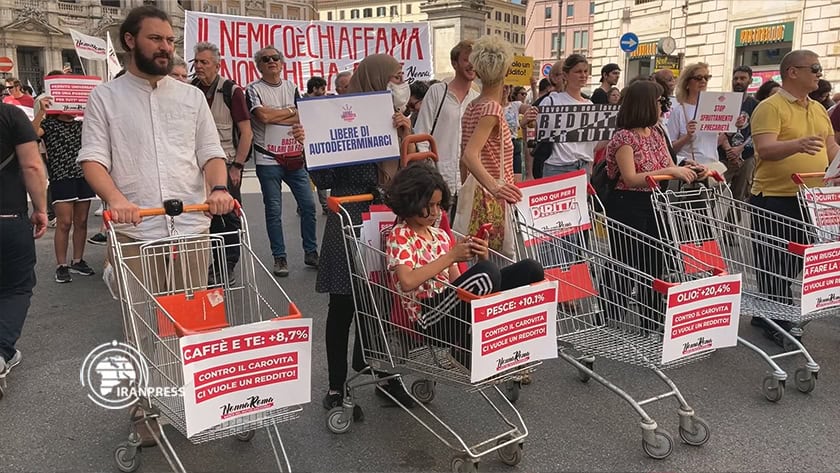Italy’s cost of living: It’s gone up here, too, folks

Living in the land of so many sweet dreams, particularly for those in countries recently circling the drain, here in Italy I have become a clearinghouse for cross-oceanic complaints. All, of course, are valid.
My American friends are wailing. Costs are skyrocketing and will get worse. One woman said she regularly spends $80 for two bags of groceries. Another is cutting back and still spending $300 a month. A friend on Medicare said he read of people whose insurance is going from $500 a month to $3,000.
I visited the United States in July last year and am still recovering from the sticker shock. A trip to a supermarket for a picnic for two cost $80. The average price of a hotel in New York topped $300 a night for the first time. I once paid $8 for a bottle of Budweiser.
Many dream of moving here to Italy where the sun always shines and so do the smiles. Well, I have news for all the downtrodden Americans wishing for a new life.
It’s more expensive here, too.
It’s not as bad as in the U.S., but my Italian friends are complaining the same as Americans. It’s just in a different language. Me? I’m fine. I don’t have a car. That drastically cuts my expenses. I live alone in a small apartment. That helps, too.
But for most of Italy, life since Covid has gone from la dolce vita (the sweet life) to vita fa schifo (life sucks). According to Istat, Italy’s statistics agency, in 2022 after Covid, Italy’s inflation jumped 8 percent. It has steadily slowed but since 2020, inflation has jumped 12 percent.
Italians are feeling the effects and have taken to the streets in protest. In that jarring 2022, energy costs skyrocketed and people burned their energy bills on street corners. Students protested rising rents. In a country with the third-largest economy in the European Union yet salaries have been stagnant since I retired here in 2014, inflation doesn’t sit well here any better than in the U.S.

The statistics
Let me toss out some numbers:
- Electricity costs this year have increased 24 percent.
- Nine out of 10 Italian households last year saw housing costs rise.
- Rents have gone up more than 8 percent since last year.
- Real estate this year rose 2.5 percent in the 10 largest cities.
- Grocery prices have risen 25-30 percent.
- Restaurant prices since 2020 have risen 19 percent, including 6 percent this year.
- Trains have increased 4.6 percent. Multi-day public transport passes in Rome have gone up 20 percent.
- Road tolls have quadrupled.
- Wine – GASP! – have gone up 7.4 percent.
It could be worse. In September 2023, Italy prime minister Giorgia Meloni signed the Anti-Inflation Quarter, a bill that controls prices of consumer goods with the cooperation of participating stores and distribution chains. Since signing the bill, Italy’s inflation has dropped ro 1.2 percent last month, below the EU average.
U.S. numbers
Meanwhile, in the U.S., costs since 2020 have gone up 24.3 percent.
Electricity has increased 13 percent since 2022, rents 28 percent, groceries 25 percent. Two-thirds of Americans are living paycheck to paycheck, including a 4 percent increase from last year.
According to World Business Watch, 65 percent of Americans feel financially squeezed, up from 58 percent in June 2024.
If misery loves company, Americans can commiserate with many Italians over a frothy cappuccino or bottle of Barolo. Actually, make it a cheap Chianti.
Italy’s cost of living increase causes
The reasons for Italy’s inflation are complicated. As in the U.S., many Italian companies, particularly utilities, jacked up their rates to make up for their massive losses during Covid. However, there are also supply chain issues and the Ukraine War. Italy gets much of its gas from Russia and the war spiked prices.
Meloni worked deals with North African countries and Azerbaijan but costs have still gone up from an average of $1.36 a liter in May 2020 to the current average of $1.75. That’s $6.62 a gallon.
Contributing to the problem is Italy’s stagnated salaries, due to a lack of production. About 80-85 percent of Italian businesses are family run. That means expansion, creativity and financial growth are not maximized. Thus, salaries have not increased, let alone kept up with inflation. And while the government has no official statistics on this, underemployment remains high.
European economists have battered Italy’s economy for being behind the times. Its structure punishes small businesses. It’s the reason so many young Italians are leaving the country for better economies in Northern Europe and beyond.
Italian’s brain drain is real.
Meanwhile, I’m not going anywhere.
My life in Rome
The only increases I’ve experienced here are my monthly home gas bill has gone from an average of about €25 in 2020 to €45 and my electric bill from €35 to €50. My grocery bill since 2020 has gone up 30 percent. I changed to a more expensive gym across the street from me. That cost jumped from €25 a month to €65. Everything else has been about the same.
My biggest increases have come, of course, in the U.S. The home association loan on my Denver condo has almost %&*#$ quadrupled in three years and my insurance on it has almost doubled. I asked if the bills come with a lubricant.
Also, I have drastically increased my travel budget.
That’s my choice. What isn’t my choice is the dollar has dropped against the euro like the Venezuelan bolivar. On Jan. 3, the euro was worth $1.03. Monday it was worth $1.16. Draw your own conclusions.
It’s 16 percent more expensive for Americans in Europe, so I can relate to my Italian neighbors. And Italians can relate to what Americans are going through in the U.S.
We’re all in this together, folks. Italy still is la dolce vita. But the price of sugar has gone up.

